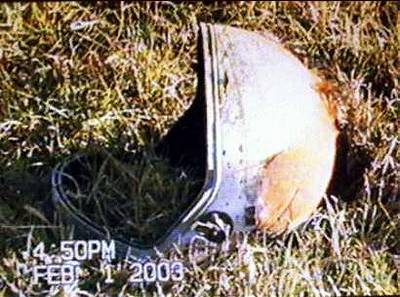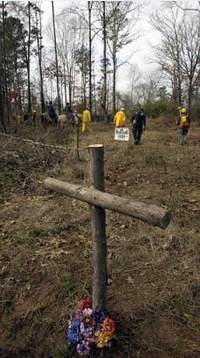Recovery Workers Enthusiastic About Grid Technique
The search for materials from the Space Shuttle Columbia
accident is entering a new phase. NASA is consolidating two of the
primary search coordination field offices and establishing four
incident command posts and base camps.

Search Intensifies
The search is intensifying based on initial success with
grid-search techniques, and because spring vegetation growth is
expected to make recovery efforts more difficult.
 Immediately after the accident, NASA established
several different local command and coordination field offices at
Barksdale Air Force Base at Shreveport, La., the Lufkin Emergency
Operations Center in Lufkin, Texas, and Naval Air Station, Joint
Reserve Base (Carswell Field), Fort Worth, Texas. The Lufkin,
Barksdale and Carswell operations will be consolidated at Lufkin
this week.
Immediately after the accident, NASA established
several different local command and coordination field offices at
Barksdale Air Force Base at Shreveport, La., the Lufkin Emergency
Operations Center in Lufkin, Texas, and Naval Air Station, Joint
Reserve Base (Carswell Field), Fort Worth, Texas. The Lufkin,
Barksdale and Carswell operations will be consolidated at Lufkin
this week.
Consolidated Effort Based In Lufkin
The consolidation at Lufkin is designed for better coordination
of search and recovery operations. Barksdale will continue to be
the receiving and shipping point for Columbia materials being sent
to NASA¹s Kennedy Space Center in Florida for final
identification.
Four interagency command posts and base camps are being
established in Corsicana, Hemphill, Nacogdoches and Palestine,
Texas, to direct intensified ground searches. Inter-agency
management teams are being deployed to the camps to conduct
searches. Up to 3,500 searchers, made up of personnel from a
variety of federal and state land management agencies, and fire
departments, will operate out of the camps under a management
structure typically used in support of wildfires. Teams of
approximately 20 trained wilderness firefighters will operate out
of the camps, and each team will conduct grid searches.
More Air Assets
In addition, air search assets are being increased to 35
helicopters. The helicopters, provided by land management agencies
and the 3,500 searchers will be working in an area that is 240
miles long. The area runs from Ellis County, south of Dallas, to
Toledo Bend Reservoir on the Texas-Louisiana border. Air
searches will concentrate on a 10-mile-wide corridor five miles on
either side of that line. Ground searches will concentrate on a
four-mile-wide corridor two miles on either side of that line. Air
searches will be conducted from Lufkin and Palestine, Texas.

More Divers, Too
The U.S. Navy is continuing to manage water recovery operations
in East Texas reservoirs, including Lake Nacogdoches and Toledo
Bend Reservoir. The underwater search is using side-scanning sonar
and dive teams from the Navy and other organizations.
NASA continues to encourage citizens to report finding any
materials suspected to be materials from the Columbia
accident. Citizens are reminded Shuttle materials may not look like
typical aircraft components. Pictures of examples of Shuttle debris
may be viewed at the following website: www.nasa.gov/columbia/COL_debris_pix.html
Anyone who discovers material suspected to be from the accident
is urged to avoid contact, because it may be hazardous as a result
of toxic propellants aboard the Shuttle.
Telephone debris reports should be made by calling, toll-free:
1-866-446-6603
Text reports and images should be e-mailed to: columbiaimages@nasa.gov
All debris is U.S. Government property and is critical to the
investigation of the mishap. All debris from the accident should be
left in place and reported to Government authorities. Unauthorized
persons found in possession of accident debris will be prosecuted
to the full extent of the law.
 NTSB Final Report: Cozy Cub
NTSB Final Report: Cozy Cub ANN FAQ: Contributing To Aero-TV
ANN FAQ: Contributing To Aero-TV Classic Aero-TV: Seated On The Edge Of Forever -- A PPC's Bird's Eye View
Classic Aero-TV: Seated On The Edge Of Forever -- A PPC's Bird's Eye View ANN's Daily Aero-Linx (04.29.25)
ANN's Daily Aero-Linx (04.29.25) ANN's Daily Aero-Term (04.29.25): Execute Missed Approach
ANN's Daily Aero-Term (04.29.25): Execute Missed Approach





